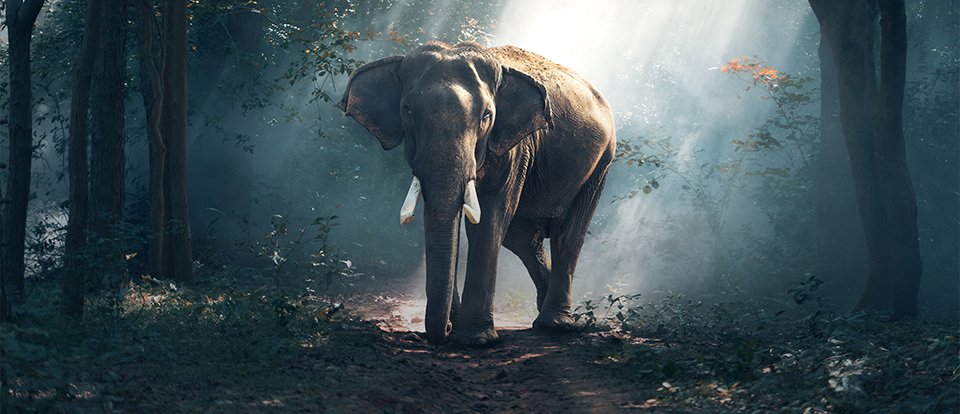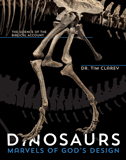Living Large
There are giants among us—giant animals, that is. God has given these incredible creatures the special features they need to live large.
King Kong clinging to the Empire State Building. The island-size Godzilla rising from the sea to belch his atomic blue flames into the sky. Water rippling with each pounding step as the T. rex approaches. Nothing inspires the imagination—or fills a theater—quite like a giant creature poised to cause destruction. While the animals rampaging across the screen are the concepts of creative writers, some of their inspiration comes from reality.
Raccoons as big as panda bears, crocodiles the length of tour buses, snakes too thick to squeeze through doorways, guinea pigs the size of cars—the fossil record is rich with examples of giant creatures that could inspire their own cinematic spin-offs. Gigantopithecus, a species of extinct ape, may have reached a height of 11 feet (3.5 m) when standing on its hind legs.1 A species of Ichthyosaur, a giant ocean reptile resembling a large dolphin, may be the largest predator ever unearthed, reaching 69 feet (21 m) long (about ten and a half times the length of a king-size bed).2 Then there were Titanosaurs (long-necked grazing dinosaurs), the biggest land animals ever discovered. The largest of the Titanosaurs may have reached staggering lengths of 122 feet (37 m)—imagine four of London’s double-decker buses sitting end-to-end. The Titanosaur replica at the American Museum of Natural History in Washington, DC, is so big that its body can’t be entirely contained in one room.
These giants are wondrous descendants of God’s original creation. In Genesis 1, God filled the earth with an incredible diversity of creatures—some that swam, some that walked on land, and some that took flight. Part of that diversity included encoding each of the first created kinds in the original creation with the genetic information to reproduce and diversify in size—including supersize.
After the flood, animals began adapting to the new environments of the ravaged world. Because of their diverse genetic coding, many animals had the tools necessary to survive in their new living conditions. Some animal descendants grew longer necks, which allowed them to reach higher food; some developed extreme speed; and some grew to incredibly large sizes.
Though we no longer encounter eight-foot beavers or two-foot dragonflies, we still have some incredible giants living among us today—like the blue whale, the elephant, and the ostrich. Though these familiar beasts may not hold the same mystique as extinct varieties, they are anything but mundane—they’re a marvel of God’s handiwork. Specially-designed features allow these modern giants to live large in today’s environments.

Big Blue
Blue Whale
- Lifespan: 80–90 years
- Average Weight: 290,000–330,000 lbs (131,542–149,685 kg)
- Heaviest: 418,878 lbs (190,000 kg)
- Average Length: 70–80 ft (21–24 m)
- Longest: 110 ft 17 in (33.58 m)
- Food Per Day: 4,400–8,000 lbs (2,000–3,629 kg) / 20–50 million calories
- Habitat: nearly every ocean

Titans of the Deep
The heaviest living animal on our planet is the Antarctic blue whale. In fact, it is the largest animal known to have existed on earth. Normally when it comes to mammals, the size prize goes to the males, but in the case of blue whales, the females reign supreme. With their bodies fully supported by salt water, these amazing creatures can reach lengths of over 100 feet (30 m) and weigh more than 400,000 pounds (180,000 kg)—that’s longer than a basketball court and heavier than the Statue of Liberty. The heart of a blue whale alone weighs more than a grand piano!
To maintain their large physique, blue whales must have access to lots of food. Turns out, the largest creatures on the planet live by consuming some of the smallest. Blue whales feast on a diet of iron-rich krill—tiny shrimp-like organisms that live throughout the earth’s oceans.
The larger blue whales grow, the more energy-efficient they become. Their size allows the whales to migrate more easily to their seasonal food locations, which are scattered all over the planet, in search of the krill that keep them so large.
Once a blue whale arrives at a krill bloom site, it swims through the cloud of small creatures and engulfs a mouthful of seawater that is larger than the whale itself, using its expandable throat pleats.3 The whale then uses its tongue—which weighs 6,000 pounds (2,722 kg)—to push the unwanted seawater through its fibrous baleen, like a juice press, until all that is left behind is a mouthful of krill. That single bite contains around half a million calories—and the blue whale might eat 100 bites a day.
As they consume their daily 20–50 million calorie diet, blue whales excrete nutrients back into the water, which feed vital phytoplankton, which in turn feed krill. So, in some ways, the whales help cultivate their own food supply.
This cycle isn’t just good for blue whales and krill—it’s also good for the whole planet. Phytoplankton absorb massive amounts of carbon dioxide and produce much of the earth’s oxygen—nearly as much oxygen as all land plants combined—giving whales a necessary role in stabilizing earth’s climate.
Depending on whether it is diving for food or swimming at the surface for air, a blue whale’s heart rate can vacillate anywhere from 2 to 37 beats per minute.4 Blue whales are able to survive this drastic swing in heart rate because of the way God equipped them with an elastic aortic arch, a special design feature in the major artery outside the heart. Each beat of a blue whale’s heart pumps 58 gallons (220 l) of blood into the main artery, where the stretchy aortic arch expands like a balloon to accommodate the large volume. The aortic arch then continues contracting, circulating the blood throughout the whale’s entire body between heartbeats.
Whale of a Tale
Many evolutionists believe that blue whales evolved from hoofed mammals (cows, camels, sheep) over 45 million years ago. For this impossible tale to be true, hoofs had to turn into fins, noses had to turn into blowholes, teeth had to turn into baleen, and a terrestrial lifestyle had to turn into an aquatic one. The impossible “missing link” between these very different creatures wouldn’t have been the fittest to survive anything, much less turn into the majestic blue whale we know today.
Evolutionary Assumptions
When we look at the complexity of the largest animals on the planet, we must throw out the evolutionary assumption that these animals evolved from completely different organisms over time. Rather, they are the generational offspring of some of the original animal kinds created on different days in the creation week.
In the Bible’s true historical account, God tells us that he created ocean creatures before he made the land animals (Genesis 1:20), and those creatures reproduced after their own kind (Genesis 1:21).
According to Their Kinds
In Genesis 1, we find the phrase “according to its kind” repeated 10 different times. God created animals with the ability to genetically reproduce within the baramin (kind) parameters he gave them. For example, the African elephant, the smaller Asian elephant, and the extinct wooly mammoth all descended from the elephant kind on the ark.
Even though the created kinds will always stay within their genetic parameters, their offspring can have tremendous genetic variety. Consider that a 79-foot (24 m) blue whale is in the same kind as a 27-foot (8 m) minke whale!
From the Beginning . . .
While evolution is the idea of organisms changing from one kind into another, natural selection (and other mechanisms) is based on certain traits that already exist in an organism’s genetic code that allow the organism to adapt to survive in a given environment. This means giant animals didn’t evolve into the largest creature on earth, but that God initially created the animal kinds with the capability to grow to large sizes due to the special design features he coded into their genetic makeup.
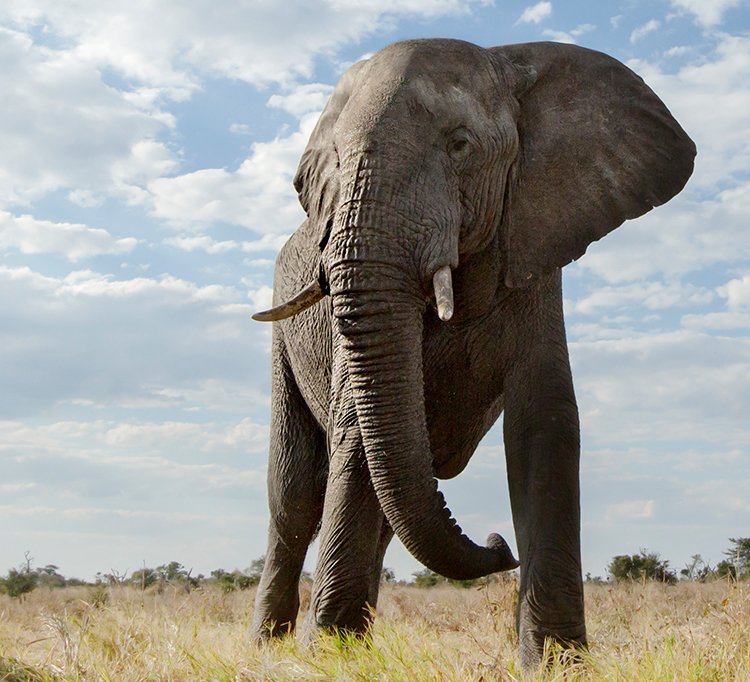
Heavyweight Land Champ
African Elephant
- Lifespan: up to 70 years
- Average Weight: 6,600–13,000 lbs (2,900–5,900 kg)
- Heaviest: 24,000 lbs (10,886 kg)
- Average Height: 7.2–10 ft (2.2–3 m)
- Tallest: 13 ft (3.96 m)
- Food Per Day: 350 lbs (159 kg) / up to 70,000 calories
- Habitat: southern and central Africa
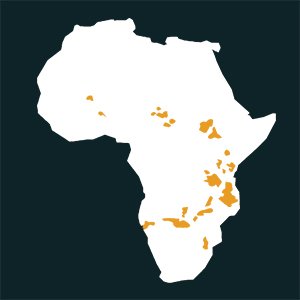
Colossals on Land
When it comes to heavyweight champions on land, the African bush elephant comes out on top. Male bush elephants are larger than females and can grow as tall as 13 feet (3.96 m) and weigh up to 13,000 pounds (5,897 kg)—about as heavy as a T. rex would have been.
An elephant’s baggy skin looks like it runs a few sizes too big, but this specific design feature serves a valuable purpose. The drapes and folds of an elephant’s skin trap in moisture, keeping the elephant cool in the hot African sun. Elephants also use the surface area of their large ears as “heat radiators”—flapping them around to lose excess body heat.5
When it comes to defense, God has given the African bush elephant incredible strength and impressive tusks. An elephant can use its tusks as weapons against predators, as shields for protecting its sensitive trunk, or sparring tools when contending with other elephants. And that baggy skin we talked about earlier? It’s heavy duty—up to an inch (2.54 cm) thick in some places! Because of this thickness, an elephant’s skin cannot be easily damaged in a fight against an equally gigantic sparring partner, yet its skin is sensitive enough to feel a fly land on it.
One reason that these giants can survive in our modern environments and live up to 70 years in the wild is that their bodies are relatively free of age-related diseases. Scientists have puzzled over why elephants, with so many cells in their bodies, are not at a higher risk for cancer than other animals. In fact, only 5% of elephants die of the disease. As they began digging into the mystery, scientists found something astonishing. It appears that God gave elephants a special “tool” in their genetic code specifically for fighting cancer.
Elephants carry extra copies of something called “tumor suppressor” genes, or TP53 genes. Research has revealed hundreds of genes that are directly and/or indirectly affected by TP53, including those linked to aging. While humans have only one copy of TP53, elephants have 20 copies.6 These cancer-suppressing genes destroy damaged cells in the elephant’s body and are possibly one of the key mechanisms that allow elephants to live long and grow to staggering sizes without higher incidence of disease-related death.
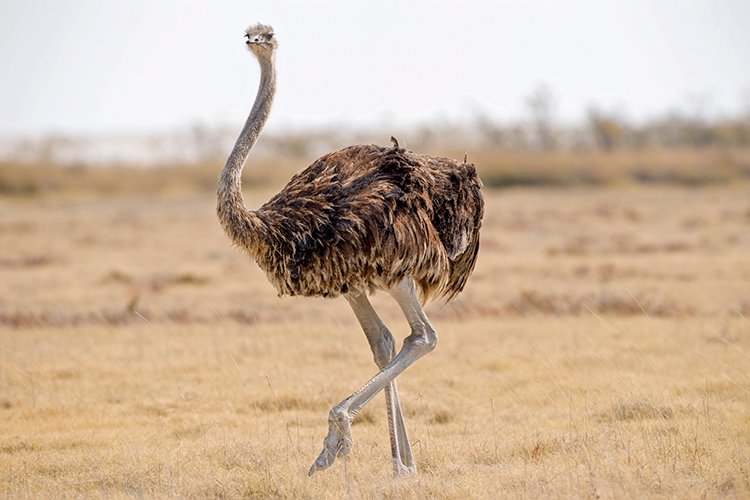
Winged Giant
Ostrich
- Lifespan: 30–40 years
- Average Weight: 140–290 lbs (63.5–131.5 kg)
- Heaviest: 340 lbs (154 kg)
- Average Height: 6–9 ft (1.8–2.7 m)
- Tallest: 9 ft (2.7 m)
- Food Per Day: 3–4 lbs (1.3–1.8 kg)
- Habitat: southern and central Africa

Winged Wonders
When searching for the bird who rules the roost, don’t look to the sky for the winner. Ostriches, the tallest and heaviest birds on earth, live their lives entirely on land. Ostriches can grow up to 9 feet (2.7 m) tall (taller than any NBA player) and weigh an average of 290 pounds (130 kg)—about the same as your refrigerator.
Ostriches don’t need the gift of flight to survive in their African savannah home; instead, they are agility masters. Able to run at continuous speeds of 30–37 mph (48–60 km/h) and reach burst speeds of 45 mph (70 km/h), ostriches use their wings in the same way a ship uses sails—for rapid braking and steering.
Unlike other birds, which have three, four, or five toes, ostriches are the only birds in the world that have two toes on each foot. While songbirds need more toes for grabbing onto branches and raptors need more toes for grabbing prey, the ostrich’s two-toed feet are designed perfectly for running at record speeds. The large toe carries the ostrich’s weight, while the small toe helps it balance. But if speed doesn’t cut it in a high-powered chase, ostriches can also go on the defensive and use their powerful leg muscles to deliver a mighty death blow to predators.
Ostriches are mentioned several times throughout the Bible as taking up residence in inhospitable places (Isaiah 34:13; Jeremiah 50:39). While it is not known for certain if ostriches were originally able to fly or if God created them to be land-bound from the beginning, what we do know is that God made ostriches adaptable and able to thrive under extreme conditions. For example, in desert environments, ostriches can tolerate air temperatures up to 132°F (56°C), and, like camels, they can travel long distances in search of food and water.
Despite the intense heat of their habitat, ostriches rarely seek shade. Instead, God allowed ostriches to develop long necks and a special circulatory system that keeps their heads at safe temperature levels, while the rest of their bodies heat up to temperature extremes that would be intolerable to most other warm-blooded animals.
Like the blue whale and elephant, the ostrich’s survival mechanisms reveal the loving care God took in designing the unique attributes that allow these creatures to thrive at such large sizes. From great to small, all living things are a testament to his majestic creativity and power.
What Are the Boundaries of Big?
Weight
Bigger animals have less surface area compared to volume (mass), while smaller animals are more proportional. And the larger the animal, the more vulnerable it is to the effects of gravity. Its mass increases faster than its width and its skeletal and muscular systems, causing the animal’s weight to crush its body. An elephant, for instance, must be careful how much time it spends lying on its side, or else it might suffocate from its own weight. Blue whales can survive their size by living in the ocean, where buoyancy allows them to weigh many times what the heaviest land animal could weigh without collapsing in on itself.
Temperature
The size of an endothermic (warm-blooded) animal is also limited by the release of energy—heat—from cells. Large animals are made of more cells that release more heat into the animal’s body. Because heat escapes through surface area, God equipped big animals (that have more volume than surface area) with specialized ways to keep themselves cool, like an elephant fanning itself with its ears or the blue whale living in icy waters. Without these cooling systems, a big animal’s blood would boil.
Large ectothermic (cold-blooded) animals like reptiles and fish have a different problem. These creatures regulate their internal temperatures by exchanging heat with their environments, so they often live in tropical climates where they spend a lot of time soaking up the sun. The larger an ectotherm grows, the more time it takes to heat up.
Even Bigger
So have creatures bumped against the boundaries of big? Not necessarily. In fact, scientists believe that even blue whales could continue growing if more krill were reliably available.
Outside the whale world, other organisms are astounding scientists with their size. Recently, scientists discovered a bacterium (Thiomargarita magnifica) 50 times larger than the previously known biggest bacterium. The size of an eyelash, this behemoth bacterium is visible to the naked eye. Scientists were amazed to discover a bacterium this large, since it exceeded the supposed size limit for a single-celled organism. It’s just another example of how God’s design displays variety and doesn’t always fit neatly into what we expect. He made some creatures big to differ—and he equipped every size with the features they need to survive and bring him glory.
Answers Magazine
January–March 2023
Footnotes
- Colin Barras, “Gigantopithecus: The story of the greatest of the great apes,” New Scientist, May 18, 2016, https://institutions.newscientist.com/article/mg23030742-800-gigantopithecus-the-story-of-the-greatest-of-the-great-apes/.
- Jason Daley, “This Ancient Reptile Was One of the Most Massive Creatures That Ever Lived,” Smithsonian Magazine, April 10, 2018, https://www.smithsonianmag.com/smart-news/new-ichthyosaur-was-one-largest-creatures-ever-existed-180968751/.
- Ed Young, “Giant Whales Have Super-Stretchy Nerves,” National Geographic, May 4, 2015, https://www.nationalgeographic.com/science/article/giant-whales-have-super-stretchy-nerves?loggedin=true&rnd=1668801695939.
- Jason Daley, “Researchers Measure a Wild Blue Whale’s Heart Rate for the First Time,” Smithsonian Magazine, November 27, 2019, https://www.smithsonianmag.com/smart-news/researchers-measure-blue-whales-heart-rate-first-time-180973662/.
- Senah Yeboah-Sampong, “ScienceShot: How Elephants Stay Cool,” July 12, 2013, https://www.science.org/content/article/scienceshot-how-elephants-stay-cool.
- Emily Hasser, “What Whales and Elephants Can Teach Us About Cancer Prevention,” Public Health Genetics, December 22, 2020, https://sites.uw.edu/phgblog/2020/12/22/whales/.
Recommended Resources

Answers in Genesis is an apologetics ministry, dedicated to helping Christians defend their faith and proclaim the good news of Jesus Christ.
- Customer Service 800.778.3390
- © 2024 Answers in Genesis


